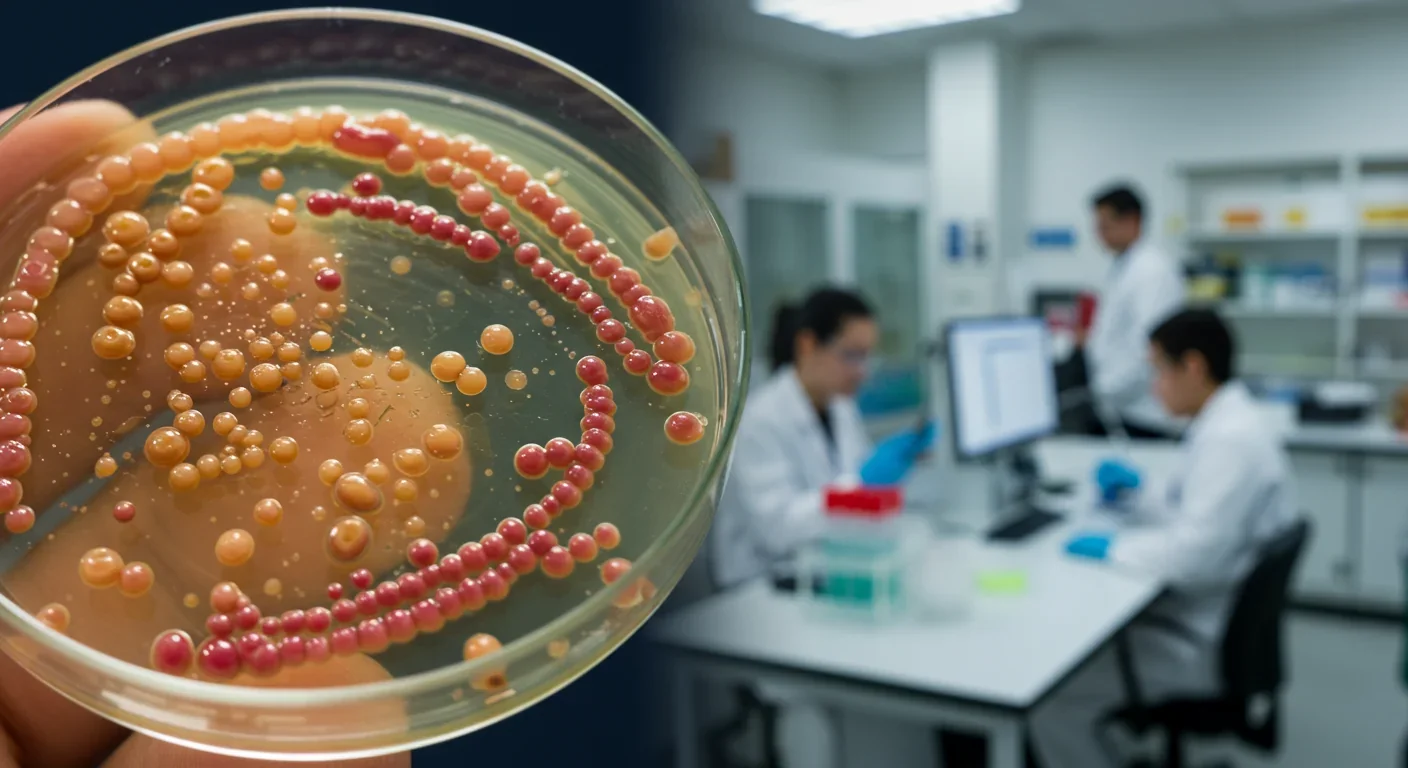Keystone Bacteria: The Missing Link in Your Gut Health

TL;DR: Scientists are pursuing therapies to reverse glycation, the process where sugar molecules permanently bond with proteins, causing tissue stiffness and aging. While early drugs failed, new approaches targeting specific cross-links and prevention strategies offer hope.

Your cells are being caramelized. Right now, as you read this, sugar molecules are colliding with proteins throughout your body, triggering a slow-motion chemical reaction that gradually transforms supple tissues into brittle, yellowed structures. This process, called glycation, might be one of the most underappreciated drivers of human aging.
But what if we could reverse it?
For decades, scientists viewed glycation damage as permanent, a one-way biochemical street leading inexorably toward wrinkles, stiff arteries, and age-related disease. That consensus is starting to crack. A new generation of therapies promises not just to slow glycation, but to break apart the sugar-protein bonds already formed, potentially restoring tissues to a more youthful state.
Glycation begins innocently enough. When glucose or fructose molecules bump into proteins, they stick together through a non-enzymatic chemical reaction known as the Maillard reaction, the same process that browns bread and sears steaks. Inside your body, though, there's nothing appetizing about it.
These initial sugar-protein attachments gradually rearrange themselves into Advanced Glycation End-products, or AGEs. The acronym is darkly appropriate. AGEs accumulate in collagen, the structural protein scaffolding that keeps skin firm and blood vessels flexible. They form cross-links between protein fibers, essentially gluing them together into rigid, dysfunctional clumps.
AGEs affect nearly every cell type in the human body. They trigger inflammatory pathways by binding to RAGE receptors on cell surfaces, a molecular alarm system that unleashes oxidative stress and activates NF-κB, a master regulator of inflammation. The result cascades through tissues: neurons struggle to transmit signals, kidney filters clog, heart muscle stiffens.
What makes glycation particularly insidious is its permanence. Most damaged proteins get recycled within days or weeks. But collagen and elastin can persist for years, accumulating glycation damage like tree rings recording environmental insults. A collagen molecule formed when you were twenty might still be supporting your skin at fifty, now thoroughly glycated and barely functional.
Not all tissues suffer equally. Glycation concentrates its assault on long-lived proteins in high-glucose environments. The cardiovascular system takes brutal punishment. AGE cross-links transform flexible arterial walls into rigid pipes, forcing the heart to work harder with each beat. Pulse wave velocity, a measure of arterial stiffness, increases predictably with AGE accumulation, creating a biological signature of vascular aging.
Your skin broadcasts glycation damage to the world. Dermal collagen, constantly bathed in glucose from nearby capillaries, becomes increasingly cross-linked with age. The elastic recoil that once snapped skin back into place falters. Wrinkles etch themselves into the glycated matrix, visible testaments to decades of molecular caramelization. Glycated skin also develops a characteristic yellowish tinge as AGEs accumulate, a phenomenon cosmetic scientists tactfully call "age-related yellowing."
The brain represents perhaps the most troubling glycation target. Neurons, which must last a lifetime, accumulate AGEs in their structural proteins and synaptic machinery. Research links elevated AGE levels to cognitive decline and Alzheimer's disease progression. AGE-RAGE interactions in brain tissue fuel chronic neuroinflammation, while glycated tau proteins form the neurofibrillary tangles characteristic of dementia.
Kidneys face a cruel irony: they filter AGEs from blood, but in the process, these toxic compounds accumulate in the delicate glomerular membranes responsible for filtration. Large AGE-carrying proteins cannot pass through the kidney's filters, so they bind to receptors on endothelial cells, triggering inflammation and progressive kidney dysfunction. Diabetics, whose high blood sugar drives accelerated glycation, often watch their kidney function deteriorate for exactly this reason.
Even your eyes crystallize with age, quite literally. The lens contains some of the longest-lived proteins in the body, crystallins that remain stable for decades. As they glycate, they lose transparency. AGEs scatter incoming light, gradually dimming vision and contributing to cataract formation.

For years, one compound held center stage in glycation reversal research: alagebrium chloride, marketed as ALT-711. Early studies showed promise. In laboratory rats, alagebrium reduced arterial stiffness and improved vascular function by cleaving existing AGE cross-links. The mechanism seemed elegant: the small molecule could slip between glycated protein fibers and chemically break the bonds holding them together.
Human trials told a different story. A rigorous year-long study divided 48 older adults into groups receiving either alagebrium or placebo, combined with exercise or no exercise. Researchers measured VO₂max, arterial stiffness via pulse wave velocity, and endothelial function. Exercise improved cardiovascular fitness as expected. Alagebrium did nothing.
The drug showed no independent effect on vascular function and didn't enhance exercise benefits. The dose was 420 mg daily, well within the range that worked in animals. But human tissue apparently differs enough from rat tissue that alagebrium's cross-link cleaving ability simply doesn't translate.
Why the failure? One critical factor emerged: glucosepane, an AGE cross-link type that comprises the overwhelming majority of glycation damage in human tissue, barely exists in rats. Alagebrium may cleave the types of cross-links abundant in laboratory animals while leaving the ones humans accumulate largely untouched.
There's also a darker concern. Breaking up cross-links indiscriminately could destabilize tissues in unexpected ways. In atherosclerotic arteries, AGE cross-links might actually help stabilize dangerous plaques. Some researchers worry that AGE-breakers could trigger plaque rupture, potentially causing heart attacks or strokes.
Glucosepane represents the next frontier. This particular AGE cross-link forms when glucose molecules bridge two amino acids, lysine and arginine, in adjacent protein chains. The resulting chemical structure locks proteins together with exceptional stability. Glucosepane dominates AGE cross-links in human collagen, especially in cardiovascular tissue, making it the primary target for any truly effective AGE-breaking therapy.
The SENS Research Foundation has invested significantly in developing glucosepane-cleaving enzymes. The challenge lies in finding or engineering proteins that can recognize the specific three-dimensional shape of a glucosepane cross-link and snip it apart without damaging surrounding tissue. Current efforts focus on bacterial enzymes that naturally break down similar compounds, hoping to adapt them for human therapeutic use.
Progress has been slow, hampered by glucosepane's chemical stability and the difficulty of working with such a rare molecule. Synthesizing glucosepane for research purposes took years to perfect. Testing potential breakers requires producing enough pure glucosepane to screen candidate enzymes, a bottleneck that has limited research speed.
While the AGE-breaker dream struggles forward, a more immediate strategy has gained traction: preventing AGE formation in the first place. Several compounds interfere with glycation's early stages, before cross-links form.
Aspirin inhibits glycation through an unexpected mechanism. It acetylates free amino groups on proteins, essentially capping the sites where sugars would normally attach. The same chemical modification that gives aspirin its anti-inflammatory properties also blocks glycation. The effect is modest but measurable, particularly at cardiovascular doses.
Metformin, the common diabetes drug, acts as a carbonyl scavenger. During glycation's intermediate stages, reactive dicarbonyl compounds form that dramatically accelerate AGE production. Metformin captures these dicarbonyls before they can react with proteins, significantly slowing AGE accumulation. This mechanism likely contributes to metformin's surprisingly broad protective effects against age-related diseases.
Aminoguanidine showed early promise as a dedicated glycation inhibitor, reacting with β-dicarbonyl intermediates to prevent their conversion into AGEs. Clinical trials for diabetic kidney disease initially looked encouraging, but the drug ultimately failed due to safety concerns about long-term use. Still, it validated the general strategy of targeting glycation intermediates.
More recent attention has focused on alpha-lipoic acid, a potent antioxidant that operates through multiple anti-glycation mechanisms. It directly scavenges reactive carbonyls and also chelates metal ions that catalyze AGE formation. A study of type 2 diabetes patients with neuropathy found that alpha-lipoic acid treatment significantly reduced serum AGE levels. Patients received 600 mg daily, a dose well-tolerated over months of therapy.
Pyridoxamine, a form of vitamin B6, reached Phase II clinical trials for diabetic kidney disease. The compound, marketed as Pyridorin, works by trapping reactive carbonyl intermediates. Trials showed it significantly decreased the rate at which creatinine levels rose, suggesting preserved kidney function. Though it hasn't reached widespread clinical use, pyridoxamine demonstrated that vitamin-derived compounds could meaningfully impact glycation in human patients.
Your body didn't evolve without countermeasures. Several endogenous systems work continuously to limit glycation damage, and understanding them points toward enhancement strategies.
Carnosine, a dipeptide naturally synthesized in muscle and brain tissue, functions as a sacrificial anti-glycation agent. It reacts with carbonyls that would otherwise attack structural proteins, essentially taking the glycation hit on your proteins' behalf. Carnosine concentrations decline with age, potentially contributing to accelerated glycation in older adults.
Supplemental carnosine has shown protective effects in multiple studies. It inhibits AGE formation in vitro and reduces markers of glycation stress in animal models. Human studies are more limited, but preliminary evidence suggests 1,500 mg daily may reduce AGE accumulation. The compound's short half-life means it must be taken multiple times daily for sustained effect.
N-acetyl carnosine, a modified version, has been formulated into eye drops for cataract treatment. The acetyl group helps it penetrate the cornea, delivering carnosine directly to the lens where it can combat crystallin glycation. Russian studies reported improvements in lens transparency, though Western replication has been sparse.
The glyoxalase enzyme system represents your primary detoxification pathway for glycation intermediates. These enzymes convert methylglyoxal and other reactive dicarbonyls into harmless acids. Glyoxalase activity varies between individuals and declines with age, raising the intriguing possibility that boosting this system could slow glycation. Researchers are exploring compounds that upregulate glyoxalase expression.
Glutathione, the cell's master antioxidant, plays an indirect but crucial anti-glycation role. It fuels the glyoxalase system and quenches oxidative stress that accelerates AGE formation. Foods rich in glutathione precursors, like the cysteine in broccoli and pork, may support anti-glycation defenses.

Not all glycation happens inside your body. The browning reactions that make food delicious also create AGEs, and you absorb a meaningful fraction of what you eat.
Studies estimate that 10-30% of dietary AGEs enter the bloodstream after digestion. That might not sound like much, but given the typical Western diet's AGE load, it adds up. High-heat cooking methods, particularly grilling, frying, and roasting, dramatically increase AGE content. The same Maillard reactions that create complex flavors and appetizing crusts also generate AGE compounds that your digestive system partially absorbs.
Foods highest in AGEs include processed items cooked at high temperatures. French fries, bacon, grilled meats, and toasted bread top the list. The combination of high heat, fats, and proteins creates ideal conditions for AGE formation. Even seemingly healthy choices like roasted nuts contain substantial AGEs compared to their raw versions.
Cooking method matters enormously. Boiling and steaming generate far fewer AGEs than dry heat methods because water limits temperature to 100°C, below the threshold where Maillard reactions accelerate. Slow-cooked stews create fewer AGEs than grilled steaks despite similar cooking times.
A study examining AGE-modified cooking approaches found that marinating meat in acidic solutions like lemon juice or vinegar before cooking reduced AGE formation by up to 50%. The acid appears to inhibit Maillard chemistry. Brief high-heat searing followed by low-temperature finishing also minimizes AGE production while still developing flavor.
This doesn't mean abandoning all high-heat cooking. The dose makes the poison. Occasional grilled meals won't destroy your health, but a diet built around fried and heavily browned foods substantially increases your AGE exposure. Balancing cooking methods and emphasizing water-based techniques for at least some meals makes biochemical sense.
If glycation drives aging, can you measure your personal glycation burden? Several biomarkers exist, though accessibility varies.
Hemoglobin A1c (HbA1c), already standard in diabetes monitoring, reflects average blood glucose over the past 2-3 months. It measures glycated hemoglobin, the percentage of red blood cell hemoglobin that has sugar molecules attached. Higher HbA1c indicates more glycation occurring throughout your body. Non-diabetics typically have HbA1c below 5.7%, while 6.5% or higher indicates diabetes.
HbA1c offers a window into glycation, but a limited one. It only captures recent glycation in one protein type and says nothing about AGE cross-link accumulation in tissues.
Fructosamine testing measures glycated serum proteins, providing a shorter-term view of glycation over 2-3 weeks. This faster turnover makes fructosamine useful for tracking rapid changes in glycemic control.
The glycation gap, the difference between measured HbA1c and calculated HbA1c derived from fructosamine levels, reveals glycation variability that HbA1c alone misses. A high glycation gap suggests blood sugar swings that average measurements obscure, potentially indicating higher AGE formation risk.
More sophisticated tests measure actual AGE compounds in blood or urine, but these remain largely research tools. Skin autofluorescence devices exploit the fact that AGEs fluoresce under ultraviolet light, allowing non-invasive estimation of skin AGE accumulation. A few research centers and longevity clinics offer this testing, providing a rough metric of cumulative glycation exposure.
While we await breakthrough therapies, several evidence-based strategies can limit glycation damage now.
Control blood sugar. This remains foundational. Higher average glucose levels drive proportionally more glycation. You don't need diabetes to benefit from blood sugar management. Even in normal ranges, lower is better for minimizing glycation. Strategies include emphasizing low-glycemic foods, combining carbohydrates with protein and fat, exercising regularly, and ensuring adequate sleep, since poor sleep disrupts glucose metabolism.
Adjust cooking methods. Favor boiling, steaming, and slow cooking over grilling, frying, and high-temperature roasting for at least some meals. When you do use high heat, marinate first in acidic solutions. This doesn't mean eating raw or bland food, but rather being strategic about how you apply heat.
Consider carnosine supplementation. With typical doses around 1,500 mg daily, carnosine appears safe and may offer anti-glycation protection. The evidence is stronger for muscle and possibly brain tissue than for systemic effects, but the risk-benefit ratio looks favorable.
Boost antioxidant intake. Alpha-lipoic acid, 600 mg daily, has clinical evidence supporting reduced AGE levels in diabetics and may benefit non-diabetics through similar mechanisms. Foods rich in polyphenols, like berries, green tea, and turmeric, show anti-glycation properties in studies. Glutathione-supporting foods, particularly cruciferous vegetables, help maintain the glyoxalase detoxification system.
Exercise regularly. Physical activity improves insulin sensitivity, reducing average blood glucose. One-year exercise training programs significantly improved VO₂max and cardiovascular risk markers even without AGE-breaking drugs. Exercise may also enhance cellular AGE clearance mechanisms, though this requires more research.
For diabetics, consider metformin. If you have diabetes or prediabetes, metformin's anti-glycation effects provide benefits beyond glucose control. Discuss with your physician whether it's appropriate for your situation.
Glycation reversal represents one of the most challenging problems in aging research. Breaking stable cross-links in living tissue without causing collateral damage requires exquisite molecular precision. Yet the potential payoff justifies the difficulty.
Imagine a therapy that could genuinely restore arterial flexibility, reverse skin aging at the molecular level, and preserve organ function by ungluing proteins throughout the body. Such a treatment might not just extend lifespan but expand healthspan, the years spent with youthful function.
The SENS Research Foundation continues working toward glucosepane-cleaving enzymes, now the most realistic path to true AGE-breaking therapy. Industry investment remains limited, as pharmaceutical companies focus on more conventional targets. Progress depends largely on non-profit research and the conviction of scientists who see glycation as a lynchpin of aging.
Meanwhile, prevention strategies become more sophisticated. Better glycation inhibitors may emerge from screening natural compounds and synthetic molecules. Some researchers are exploring topical applications for skin, where direct delivery could reverse visible aging without systemic exposure.
Gene therapy offers a wildcard possibility. Enhancing endogenous glyoxalase expression through targeted gene editing could boost natural AGE clearance throughout life. Early animal studies show promise, though human applications remain distant.
The ethics of glycation reversal raise few concerns compared to other longevity interventions. Reducing toxic cross-links in proteins simply restores normal function rather than pushing beyond evolved limits. If we succeed, glycation reversal will feel less like enhancement and more like good maintenance, keeping tissues running as biology intended.
Your proteins are still being caramelized. But you now understand the process and can take steps to slow it. And sometime in the next decade or two, as aging research continues its unexpected acceleration, true glycation reversal might move from theoretical possibility to clinical reality. The sugar bonds that currently seem permanent may prove temporary after all.

Fast Radio Bursts—millisecond flashes from distant galaxies releasing more energy than the Sun in days—have evolved from cosmic oddities into powerful tools. Advanced telescopes like CHIME now detect dozens weekly, tracing origins to specific galaxies and even individual stars. Magnetars, ultra-magnetized neutron stars, are confirmed sources, yet mysteries abound: repeaters in dead galaxies, second-scale periodicities, and absence of X-ray counterparts. FRBs now map invisible baryons, measure...

Scientists are revolutionizing gut health by identifying 'keystone' bacteria—crucial microbes that hold entire microbial ecosystems together. By engineering and reintroducing these missing bacterial linchpins, researchers can transform dysfunctional microbiomes into healthy ones, opening new treatments for diseases from IBS to depression.

Marine permaculture—cultivating kelp forests using wave-powered pumps and floating platforms—could sequester carbon 20 times faster than terrestrial forests while creating millions of jobs, feeding coastal communities, and restoring ocean ecosystems. Despite kelp's $500 billion in annual ecosystem services, fewer than 2% of global kelp forests have high-level protection, and over half have vanished in 50 years. Real-world projects in Japan, Chile, the U.S., and Europe demonstrate economic via...

Our attraction to impractical partners stems from evolutionary signals, attachment patterns formed in childhood, and modern status pressures. Understanding these forces helps us make conscious choices aligned with long-term happiness rather than hardwired instincts.

Crows and other corvids bring gifts to humans who feed them, revealing sophisticated social intelligence comparable to primates. This reciprocal exchange behavior demonstrates theory of mind, facial recognition, and long-term memory.

Cryptocurrency has become a revolutionary tool empowering dissidents in authoritarian states to bypass financial surveillance and asset freezes, while simultaneously enabling sanctioned regimes to evade international pressure through parallel financial systems.

Blockchain-based social networks like Bluesky, Mastodon, and Lens Protocol are growing rapidly, offering user data ownership and censorship resistance. While they won't immediately replace Facebook or Twitter, their 51% annual growth rate and new economic models could force Big Tech to fundamentally change how social media works.